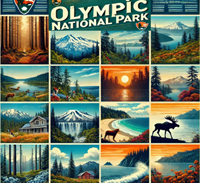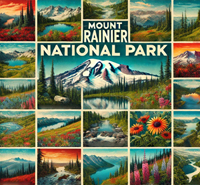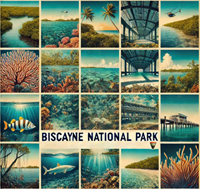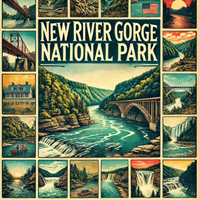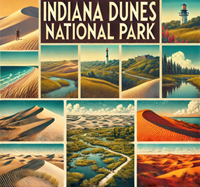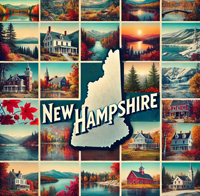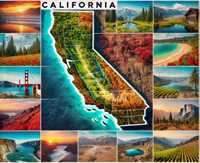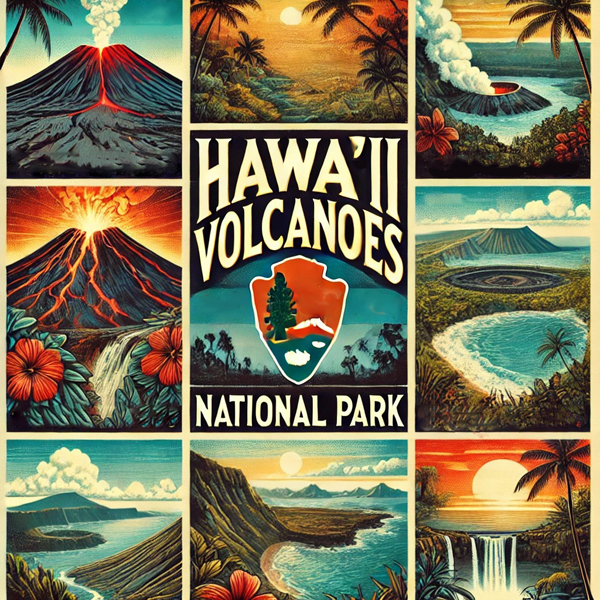
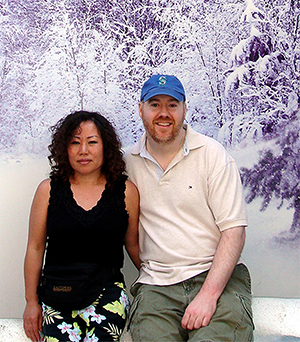
Embark on a journey curated by seasoned explorers William and Hui Cha Stanek, who have spent decades immersing themselves in the diverse landscapes of North America. These itineraries are more than just travel plans - they are thoughtfully crafted adventures designed to help you connect with the natural world, discover hidden gems, and create lasting memories.
National Parks Index | US Itineraries Index | American Roadtrips Index

Bring home a Bugville Critters book and watch as your child's love for reading and learning grows with every page. Hand-painted illustrations bring the heartwarming stories to life. Ask your librarian to add Bugville Critters to the library's digital collection today!
Discover William Stanek's Exclusive Art Collection
Explore and purchase the stunning art featured on this site. Own a piece of William Stanek's unique and captivating artwork today!
(May 2, 2025) Exploring the Big Island: A 5-Day Journey Through Hawaii's Natural Wonders
Introduction: Discovering the Diversity of the Big Island
The Big Island of Hawaii is a land of contrasts, where fiery volcanoes meet lush rainforests, and black sand beaches give way to turquoise waters. This five-day journey will take you through the island's most stunning landscapes, including the awe-inspiring Hawaii Volcanoes National Park. With stays in Kona, Volcano Village, and Hilo, you'll experience the full range of what the Big Island has to offer – from vibrant marine life and towering waterfalls to the dramatic power of Kīlauea, one of the world's most active volcanoes.
Whether you're exploring ancient lava flows, snorkeling in crystal-clear bays, or marveling at the starlit skies atop Mauna Kea, each day promises new adventures and unforgettable memories. Let's embark on this journey together, discovering the beauty, culture, and spirit of the Big Island of Hawaii.
Day 1: Arrival and Exploring Kona's Coastline
Morning: Arrival in Kona
Overview
Your Big Island adventure begins with your arrival at Kona International Airport. After picking up your rental car, head to your accommodation in Kailua-Kona, a charming town known for its rich history, beautiful beaches, and vibrant coffee culture. After checking in, take some time to settle in and enjoy the stunning ocean views from your hotel or vacation rental.
Tips from William
"Kona is the perfect base for exploring the western side of the Big Island. Upon arrival, take a moment to relax and soak in the tropical atmosphere. If you have time, set up your camera to capture the stunning sunset views over the Pacific Ocean right from your balcony."
Insights from Hui Cha
"Arriving in Kona feels like stepping into paradise. The warm tropical breeze, the sound of the waves crashing on the shore, and the lush greenery create a sense of peace and anticipation for the adventures ahead."
How to Access Kona
Directions:
- Kona International Airport is located about 8 miles north of Kailua-Kona. The drive to your accommodation in Kailua-Kona takes about 15 minutes via Queen Kaʻahumanu Highway (Hwy 19).
Accommodation Details:
- Location: Kailua-Kona, Big Island, HI
- Amenities: Many accommodations in Kona offer ocean views, easy access to beaches, and proximity to shops and restaurants.
Photography Tips: For the best shots of the Kona coastline, set up your tripod near the water's edge in the early morning or late afternoon when the light is soft and the ocean is calm.
Alternative Activity: If you arrive early and have some time, consider taking a stroll along Aliʻi Drive, Kona's main street, where you can explore local shops, art galleries, and historic sites like the Huliheʻe Palace.
Mid-Morning: Snorkeling at Kahaluʻu Beach Park
Overview
After settling in, head to Kahaluʻu Beach Park, one of the best snorkeling spots on the Big Island. This protected bay is home to vibrant coral reefs, colorful fish, and green sea turtles (honu). The calm, clear waters make it an ideal spot for beginners and experienced snorkelers alike. Don't forget your underwater camera to capture the amazing marine life you'll encounter!
Tips from William
"Kahaluʻu Beach Park is perfect for underwater photography. Bring a waterproof camera or GoPro to capture the colorful fish and coral reefs. If you're lucky, you might even spot a sea turtle! The best time for snorkeling is in the mid-morning when the sun is high, and the visibility is at its best."
Insights from Hui Cha
"Snorkeling at Kahaluʻu Beach Park is like stepping into an underwater world. The sight of the vibrant coral, the feel of the warm ocean water, and the excitement of spotting a sea turtle create an unforgettable experience in Kona."
How to Access Kahaluʻu Beach Park
Directions:
- Kahaluʻu Beach Park is located about 5 miles south of Kailua-Kona along Aliʻi Drive. The beach park has ample parking, and snorkeling gear is available for rent nearby.
Snorkeling Details:
- Location: Kahaluʻu Beach Park, Kailua-Kona, Big Island, HI
- Difficulty: Easy to Moderate
Photography Tips: For the best underwater shots, use a camera with an underwater housing or a GoPro. Keep your movements slow and steady to avoid disturbing the marine life, and try to shoot in the mid-morning when the light is best for capturing the vibrant colors of the coral and fish.
Alternative Activity: If snorkeling isn't your thing, consider taking a stand-up paddleboarding (SUP) lesson at Kahaluʻu Beach, where you can enjoy the calm waters and beautiful scenery from a different perspective.
Afternoon: Exploring Puʻuhonua o Hōnaunau National Historical Park
Overview
In the afternoon, take a short drive south to Puʻuhonua o Hōnaunau National Historical Park, also known as the Place of Refuge. This sacred site was once a place of sanctuary for ancient Hawaiians who broke kapu (sacred laws) or sought refuge during times of war. Today, it's a beautifully preserved park where you can explore ancient temples, royal fishponds, and reconstructed thatched hale (houses), all set against the backdrop of the stunning Kona coastline.
Tips from William
"Puʻuhonua o Hōnaunau is a great spot for cultural and landscape photography. Bring a wide-angle lens to capture the expansive views of the coastline and the historic structures, and a telephoto lens for close-up shots of the intricate carvings and stonework. The best light for photography is in the late afternoon when the sun is lower in the sky."
Insights from Hui Cha
"Exploring Puʻuhonua o Hōnaunau is like stepping back in time. The sight of the ancient temples, the sound of the waves crashing on the shore, and the sense of history that permeates the area create a deep connection to the culture and traditions of Hawaii."
How to Access Puʻuhonua o Hōnaunau National Historical Park
Directions:
- Puʻuhonua o Hōnaunau is located about 20 miles south of Kailua-Kona along Hwy 11. The park is well-signposted, and there is ample parking on-site.
Park Details:
- Location: Puʻuhonua o Hōnaunau, Big Island, HI
- Difficulty: Easy (short walks with some uneven terrain)
Photography Tips: For the best shots in the park, focus on capturing the contrast between the ancient structures and the natural landscape. A polarizing filter can help reduce glare from the ocean and enhance the colors of the sky and sea.
Alternative Activity: If you prefer a more active afternoon, consider hiking the nearby 1871 Trail, which takes you along the coastline and offers beautiful views of the ocean and lava fields.
Evening: Sunset Dinner in Kailua-Kona
Overview
End your day with a relaxing dinner in Kailua-Kona, where you can enjoy fresh seafood and local Hawaiian cuisine while watching the sunset over the Pacific Ocean. There are plenty of oceanfront restaurants along Aliʻi Drive where you can dine with a view.
Tips from William
"Kailua-Kona is a great place for sunset photography. Bring a wide-angle lens to capture the full scope of the sunset over the ocean, and consider using a graduated neutral density filter to balance the exposure between the bright sky and the darker land."
Insights from Hui Cha
"Watching the sunset over the Pacific Ocean while enjoying a delicious meal is a perfect way to end your first day on the Big Island. The colors of the sky, the sound of the waves, and the taste of fresh seafood create a magical and memorable experience."
How to Access Kailua-Kona Restaurants
Directions:
- Most of the popular restaurants in Kailua-Kona are located along Aliʻi Drive, within walking distance of many hotels and vacation rentals.
Dining Details:
- Location: Kailua-Kona, Big Island, HI
- Cuisine: Hawaiian, seafood, international
Photography Tips: For the best sunset shots, position yourself at a restaurant with an oceanfront view. Use a small aperture (f/16 or smaller) to keep the entire scene in focus, and experiment with different compositions to highlight the layers and textures of the sky and sea.
Alternative Activity: If you prefer a more casual evening, consider picking up some poke (Hawaiian raw fish salad) from a local market and having a picnic on the beach while watching the sunset.
Day 2: Exploring the Kohala Coast and Waimea
Morning: Visit to Puʻukoholā Heiau National Historic Site
Overview
Start your second day with a visit to Puʻukoholā Heiau National Historic Site, located on the northern Kohala Coast. This sacred temple, or heiau, was built by King Kamehameha I in the late 18th century and played a key role in his unification of the Hawaiian Islands. The site offers a fascinating glimpse into Hawaii's history and culture, with sweeping views of the coastline and Mauna Kea in the distance.
Tips from William
"Puʻukoholā Heiau is a fantastic spot for cultural and landscape photography. Bring a wide-angle lens to capture the heiau against the backdrop of the ocean and mountains, and a telephoto lens for close-up shots of the stonework and surrounding vegetation. The best light for photography is in the early morning when the sun is low in the sky."
Insights from Hui Cha
"Visiting Puʻukoholā Heiau is a deeply moving experience. The sight of the ancient temple, the sound of the wind in the grass, and the sense of history that permeates the area create a powerful connection to Hawaii's past."
How to Access Puʻukoholā Heiau National Historic Site
Directions:
- Puʻukoholā Heiau is located about 30 miles north of Kailua-Kona along Hwy 19. The site is well-signposted, and there is ample parking on-site.
Site Details:
- Location: Puʻukoholā Heiau, Big Island, HI
- Difficulty: Easy (short walks with some uneven terrain)
Photography Tips: For the best shots at Puʻukoholā Heiau, focus on capturing the contrast between the ancient stone temple and the surrounding landscape. A polarizing filter can help reduce glare from the ocean and enhance the colors of the sky and vegetation.
Alternative Activity: If you prefer a more active morning, consider hiking the nearby Ala Kahakai National Historic Trail, which takes you along the coast and offers beautiful views of the ocean and ancient Hawaiian sites.
Mid-Morning: Exploring the Pololū Valley Lookout
Overview
After visiting Puʻukoholā Heiau, continue your journey north to the Pololū Valley Lookout, one of the most stunning viewpoints on the Big Island. The lookout offers breathtaking views of the lush Pololū Valley and its black sand beach, with the dramatic cliffs of the Kohala Coast rising in the background. If you're up for a challenge, you can hike down to the valley floor and explore the beach and river below.
Tips from William
"Pololū Valley is perfect for landscape photography. Bring a wide-angle lens to capture the sweeping views of the valley and cliffs, and consider using a polarizing filter to enhance the colors of the ocean and sky. The best light for photography is in the late morning when the sun is high enough to illuminate the valley but not too harsh."
Insights from Hui Cha
"Standing at the Pololū Valley Lookout is a breathtaking experience. The sight of the lush valley, the sound of the waves crashing on the black sand beach, and the views of the dramatic cliffs create a sense of awe and connection to the natural beauty of Hawaii."
How to Access Pololū Valley Lookout
Directions:
- Pololū Valley Lookout is located at the end of Hwy 270, about 20 miles north of Puʻukoholā Heiau. The lookout has a small parking area, but it can fill up quickly, so it's best to arrive early.
Lookout Details:
- Location: Pololū Valley, Big Island, HI
- Difficulty: Easy (lookout), Moderate to Strenuous (hike down to the valley)
Photography Tips: For the best shots at Pololū Valley, position yourself at the edge of the lookout to capture the full scope of the valley and cliffs. Use a small aperture (f/16 or smaller) to keep the entire scene in focus, and experiment with different compositions to highlight the layers and textures of the landscape.
Alternative Activity: If hiking down to the valley sounds too challenging, consider exploring the nearby towns of Hawi and Kapaʻau, where you can visit local shops, art galleries, and the statue of King Kamehameha I.
Afternoon: Lunch and Exploration in Waimea
Overview
After your visit to Pololū Valley, head south to Waimea (also known as Kamuela), a charming town nestled in the rolling green hills of the Big Island's interior. Waimea is known for its paniolo (Hawaiian cowboy) culture, with ranches and rodeos playing a central role in the town's identity. Enjoy lunch at one of Waimea's local restaurants, where you can sample fresh, locally sourced cuisine. After lunch, take some time to explore the town, visit local shops, and learn about the area's history at the Parker Ranch Museum.
Tips from William
"Waimea is a great place for cultural and documentary photography. Bring a portrait lens to capture the details of the town's architecture and the people you meet, and a wide-angle lens for environmental portraits that include the surrounding landscape."
Insights from Hui Cha
"Exploring Waimea is like stepping into a different side of Hawaii. The sight of the rolling green hills, the sound of the wind in the grass, and the connection to the paniolo culture create a unique and enriching experience on the Big Island."
How to Access Waimea
Directions:
- Waimea is located about 30 miles south of Pololū Valley along Hwy 250 or Hwy 19. The town is easily accessible by car, with ample parking available near the main street.
Activity Details:
- Location: Waimea, Big Island, HI
- Difficulty: Easy
Photography Tips: For the best shots in Waimea, focus on capturing the town's unique blend of Hawaiian and cowboy culture. A tripod can help stabilize your camera for sharp images, especially in the low light of the early afternoon.
Alternative Activity: If you prefer a more active afternoon, consider hiking the nearby Puʻu Huluhulu Trail, which offers stunning views of Mauna Kea and the surrounding landscape.
Evening: Sunset at Hapuna Beach
Overview
End your day with a sunset visit to Hapuna Beach, one of the Big Island's most beautiful white sand beaches. Hapuna Beach is known for its clear turquoise waters, soft white sand, and stunning sunsets. Whether you choose to swim, relax on the beach, or take a leisurely walk along the shore, Hapuna Beach offers the perfect setting for a peaceful and scenic evening.
Tips from William
"Hapuna Beach is a fantastic spot for sunset photography. Bring a wide-angle lens to capture the full scope of the beach and ocean, and consider using a graduated neutral density filter to balance the exposure between the bright sky and the darker land."
Insights from Hui Cha
"Watching the sunset at Hapuna Beach is a peaceful and awe-inspiring experience. The colors of the sky, the sound of the waves gently lapping on the shore, and the feel of the soft sand beneath your feet create a perfect ending to your day."
How to Access Hapuna Beach
Directions:
- Hapuna Beach is located about 15 miles south of Waimea along Hwy 19. The beach has a large parking area, but it can fill up quickly, so it's best to arrive early.
Beach Details:
- Location: Hapuna Beach, Big Island, HI
- Difficulty: Easy
Photography Tips: For the best sunset shots at Hapuna Beach, position yourself near the water's edge to capture the reflections in the sand and the waves as they come in. Use a small aperture (f/16 or smaller) to keep the entire scene in focus, and experiment with different compositions to highlight the layers and textures of the sky and sea.
Alternative Activity: If Hapuna Beach is too crowded, consider heading to nearby Spencer Beach Park, where you can enjoy equally beautiful views of the sunset in a more secluded setting.
Day 3: Exploring Hawaii Volcanoes National Park
Morning: Drive to Volcano Village
Overview
On your third day, pack up and head east to Volcano Village, a charming town located just outside Hawaii Volcanoes National Park. The drive from Kona to Volcano takes you through some of the Big Island's most diverse landscapes, from sunny coastal plains to lush rainforests. Along the way, you'll have the opportunity to stop at various points of interest, including coffee farms, scenic overlooks, and waterfalls.
Tips from William
"The drive to Volcano Village offers some fantastic opportunities for landscape photography. Bring a wide-angle lens to capture the expansive views of the coast and mountains, and a telephoto lens for close-up shots of the waterfalls and vegetation. The best light for photography is in the early morning when the sun is low in the sky."
Insights from Hui Cha
"The drive from Kona to Volcano Village is a journey through the Big Island's diverse landscapes. The changing scenery, the possibility of wildlife sightings, and the anticipation of exploring Hawaii Volcanoes National Park make this a memorable start to your third day."
How to Access Volcano Village
Directions:
- Volcano Village is located about 90 miles southeast of Kailua-Kona along Hwy 11. The drive takes about 2.5 hours, depending on traffic and stops along the way.
Drive Details:
- Location: Volcano Village, Big Island, HI
- Difficulty: Easy to Moderate (depending on road conditions)
Photography Tips: For the best shots along the drive, focus on capturing the wide-open landscapes and any waterfalls you might encounter. Use a telephoto lens for close-ups of the vegetation and wildlife, and a wide-angle lens for expansive views of the coast and mountains.
Alternative Activity: If you have time, consider stopping at the Punaluʻu Black Sand Beach along the way, where you can see sea turtles basking in the sun and explore the unique black sand shoreline.
Mid-Morning: Exploring the Kīlauea Visitor Center and Crater Rim Drive
Overview
After arriving in Volcano Village, head straight to Hawaii Volcanoes National Park to begin your exploration of this incredible volcanic landscape. Start your visit at the Kīlauea Visitor Center, where you can learn about the park's geology, history, and current volcanic activity through interactive exhibits and ranger-led programs. Afterward, take a scenic drive along Crater Rim Drive, which offers stunning views of the Kīlauea Caldera, steam vents, and lava fields.
Tips from William
"Hawaii Volcanoes National Park is a must-see for any photographer. Bring a wide-angle lens to capture the expansive views of the caldera and lava fields, and a telephoto lens for close-up shots of the steam vents and volcanic rock. The best light for photography is in the late morning when the sun is high enough to illuminate the landscape but not too harsh."
Insights from Hui Cha
"Exploring Hawaii Volcanoes National Park is like stepping into another world. The sight of the steaming caldera, the smell of sulfur in the air, and the sounds of the earth shifting and cracking beneath your feet create a powerful connection to the raw power of nature."
How to Access Kīlauea Visitor Center and Crater Rim Drive
Directions:
- The Kīlauea Visitor Center is located just inside the entrance to Hawaii Volcanoes National Park, about 2 miles from Volcano Village. Crater Rim Drive begins near the visitor center and loops around the Kīlauea Caldera.
Drive Details:
- Location: Hawaii Volcanoes National Park, Big Island, HI
- Difficulty: Easy to Moderate (depending on road conditions)
Photography Tips: For the best shots along Crater Rim Drive, focus on capturing the contrast between the volcanic landscape and the surrounding rainforest. A polarizing filter can help reduce glare from the steam vents and enhance the colors of the vegetation.
Alternative Activity: If Crater Rim Drive is closed due to volcanic activity, consider exploring the nearby Chain of Craters Road, which takes you down to the coast and offers stunning views of lava flows, sea cliffs, and petroglyphs.
Afternoon: Hiking the Kīlauea Iki Trail
Overview
In the afternoon, embark on a hike along the Kīlauea Iki Trail, one of the most popular and rewarding hikes in Hawaii Volcanoes National Park. This 4-mile loop trail takes you down into the Kīlauea Iki Crater, which was the site of a dramatic eruption in 1959. The trail offers stunning views of the crater, steaming vents, and the surrounding rainforest, as well as the opportunity to walk across a hardened lava lake.
Tips from William
"The Kīlauea Iki Trail is perfect for landscape and documentary photography. Bring a wide-angle lens to capture the expansive views of the crater and lava lake, and a telephoto lens for close-up shots of the steam vents and vegetation. The best light for photography is in the early afternoon when the sun is high enough to illuminate the crater but not too harsh."
Insights from Hui Cha
"Hiking the Kīlauea Iki Trail is a journey through one of the most dynamic and active landscapes in the world. The sight of the steaming crater, the sound of the earth shifting beneath your feet, and the views of the surrounding rainforest create a sense of awe and connection to the power of nature."
How to Access the Kīlauea Iki Trail
Directions:
- The Kīlauea Iki Trailhead is located along Crater Rim Drive, about 2 miles from the Kīlauea Visitor Center. The trail is well-marked and easy to follow.
Trail Details:
- Trail Length: 4 miles round-trip
- Elevation Gain: 400 feet
- Difficulty: Moderate
Photography Tips: For the best shots along the Kīlauea Iki Trail, focus on capturing the contrast between the volcanic landscape and the surrounding rainforest. A tripod can help stabilize your camera for sharp images, especially in the low light under the forest canopy.
Alternative Activity: If the Kīlauea Iki Trail sounds too challenging, consider taking the shorter Devastation Trail, a 1-mile round-trip walk that offers beautiful views of the cinder fields and surrounding landscape with less elevation gain.
Evening: Volcano Glow at Halemaʻumaʻu Crater
Overview
End your day with a visit to the Halemaʻumaʻu Crater overlook, where you can witness the incredible sight of the crater glowing with molten lava. The best time to see the glow is at dusk or after dark when the contrast between the bright lava and the dark sky creates a stunning display. This is a must-see experience in Hawaii Volcanoes National Park and one that you'll never forget.
Tips from William
"Halemaʻumaʻu Crater is a fantastic spot for night photography. Bring a tripod to stabilize your camera for long exposures, and use a telephoto lens to zoom in on the details of the glowing lava. The best light for photography is in the early evening or after dark when the glow is most visible."
Insights from Hui Cha
"Watching the glow of the lava at Halemaʻumaʻu Crater is a humbling and awe-inspiring experience. The sight of the molten lava bubbling in the crater, the sound of the earth rumbling beneath your feet, and the connection to the power of nature create a lasting memory that you'll carry with you long after you've left."
How to Access Halemaʻumaʻu Crater Overlook
Directions:
- The Halemaʻumaʻu Crater overlook is located along Crater Rim Drive, about 2 miles from the Kīlauea Visitor Center. The overlook is well-marked and easily accessible by a short walk from the parking area.
Viewpoint Details:
- Location: Hawaii Volcanoes National Park, Big Island, HI
- Difficulty: Easy
Photography Tips: For the best shots of the volcano glow, position yourself at the edge of the overlook to capture the full scope of the crater and lava. Use a small aperture (f/16 or smaller) to keep the entire scene in focus, and experiment with different compositions to highlight the layers and textures of the landscape.
Alternative Activity: If the overlook is crowded, consider visiting the nearby Jaggar Museum, which also offers great views of the crater and exhibits on the park's volcanic activity.
Day 4: Exploring Hilo and Akaka Falls
Morning: Drive to Hilo and Visit to Rainbow Falls
Overview
On your fourth day, head northeast to the town of Hilo, known for its lush rainforests, beautiful gardens, and cascading waterfalls. Start your visit with a stop at Rainbow Falls, a stunning 80-foot waterfall located just outside Hilo. The falls are known for the rainbows that often appear in the mist on sunny mornings, making this a perfect spot for photography and nature watching.
Tips from William
"Rainbow Falls is a great spot for waterfall photography. Bring a tripod to stabilize your camera for long exposures, and use a polarizing filter to reduce glare and enhance the colors of the water and vegetation. The best light for photography is in the early morning when the sun is low in the sky."
Insights from Hui Cha
"Watching the water cascade over Rainbow Falls is a peaceful and rejuvenating experience. The sight of the mist rising from the falls, the sound of the water crashing into the pool below, and the possibility of seeing a rainbow create a perfect start to your day in Hilo."
How to Access Rainbow Falls
Directions:
- Rainbow Falls is located about 2 miles west of downtown Hilo along Wailuku River State Park. The falls are easily accessible by a short walk from the parking area.
Waterfall Details:
- Location: Rainbow Falls, Hilo, Big Island, HI
- Difficulty: Easy
Photography Tips: For the best shots of Rainbow Falls, position yourself at the overlook to capture the full scope of the waterfall and the surrounding vegetation. Use a slow shutter speed to create a silky effect on the water, and experiment with different compositions to highlight the layers and textures of the landscape.
Alternative Activity: If Rainbow Falls is crowded, consider visiting the nearby Boiling Pots, a series of terraced pools and cascades along the Wailuku River that offer beautiful views and a more secluded setting.
Mid-Morning: Exploring the Hilo Farmers Market and Downtown
Overview
After your visit to Rainbow Falls, head into downtown Hilo to explore the Hilo Farmers Market, one of the best places on the island to sample fresh local produce, tropical fruits, and handmade crafts. The market is open daily, with the largest selection of vendors on Wednesdays and Saturdays. After browsing the market, take some time to explore downtown Hilo, where you can visit local shops, art galleries, and historic sites.
Tips from William
"Hilo is a great place for street and documentary photography. Bring a portrait lens to capture the details of the market and the people you meet, and a wide-angle lens for environmental portraits that include the surrounding architecture."
Insights from Hui Cha
"Exploring the Hilo Farmers Market is a fun and engaging experience. The sight of the colorful fruits and vegetables, the sound of vendors calling out their wares, and the taste of fresh tropical produce create a perfect morning in Hilo."
How to Access Hilo Farmers Market and Downtown
Directions:
- The Hilo Farmers Market is located in the heart of downtown Hilo, along the intersection of Mamo Street and Kamehameha Avenue. Parking is available in nearby lots and on the street.
Market Details:
- Location: Hilo, Big Island, HI
- Difficulty: Easy
Photography Tips: For the best shots at the Hilo Farmers Market, focus on capturing the vibrant colors and textures of the produce and crafts. A tripod can help stabilize your camera for sharp images, especially in the low light of the market stalls.
Alternative Activity: If you prefer a more active morning, consider taking a walk through Liliʻuokalani Gardens, a beautiful Japanese-style garden located along the Hilo Bayfront that offers peaceful views of the ocean and surrounding landscape.
Afternoon: Hike to Akaka Falls
Overview
In the afternoon, embark on a hike to Akaka Falls, one of the Big Island's most iconic and beautiful waterfalls. The trail to Akaka Falls takes you through a lush rainforest filled with tropical plants, bamboo groves, and cascading streams. The highlight of the hike is the 442-foot waterfall, which plunges into a deep gorge below. The trail also offers views of Kahūnā Falls, another stunning waterfall located upstream.
Tips from William
"Akaka Falls is perfect for landscape and waterfall photography. Bring a tripod to stabilize your camera for long exposures, and use a polarizing filter to reduce glare and enhance the colors of the water and vegetation. The best light for photography is in the early afternoon when the sun is high enough to illuminate the falls but not too harsh."
Insights from Hui Cha
"Hiking to Akaka Falls is a journey into the heart of the Big Island's lush rainforest. The sight of the towering waterfall, the sound of the water crashing into the gorge below, and the views of the surrounding vegetation create a sense of awe and connection to the natural beauty of Hawaii."
How to Access Akaka Falls
Directions:
- Akaka Falls State Park is located about 11 miles north of Hilo along Hwy 220. The trailhead is well-signposted, and there is ample parking on-site.
Trail Details:
- Trail Length: 0.4 miles round-trip
- Elevation Gain: 65 feet
- Difficulty: Easy
Photography Tips: For the best shots at Akaka Falls, position yourself at the overlook to capture the full scope of the waterfall and the surrounding vegetation. Use a slow shutter speed to create a silky effect on the water, and experiment with different compositions to highlight the layers and textures of the landscape.
Alternative Activity: If the hike to Akaka Falls sounds too short, consider exploring the nearby Pepeʻekeo Scenic Drive, a 4-mile route that takes you through lush rainforests, past waterfalls, and along the coast with stunning ocean views.
Evening: Dinner in Hilo and Lava Boat Tour
Overview
End your day with a relaxing dinner in Hilo, where you can enjoy fresh seafood and local Hawaiian cuisine at one of the town's many restaurants. After dinner, consider taking a lava boat tour, where you'll have the opportunity to see molten lava flowing into the ocean from an active volcanic vent. This dramatic sight is one of the most unforgettable experiences on the Big Island and offers a unique perspective on the island's volcanic activity.
Tips from William
"A lava boat tour is a fantastic opportunity for night photography. Bring a tripod to stabilize your camera for long exposures, and use a telephoto lens to zoom in on the details of the glowing lava. The best light for photography is after dark when the contrast between the bright lava and the dark sky is most dramatic."
Insights from Hui Cha
"Watching molten lava flow into the ocean from a boat is a humbling and awe-inspiring experience. The sight of the red-hot lava meeting the cool ocean water, the sound of the steam hissing and crackling, and the connection to the raw power of nature create a lasting memory that you'll carry with you long after you've left."
How to Access Lava Boat Tours
Directions:
- Lava boat tours typically depart from Hilo Harbor or nearby Pohoiki Bay. Be sure to book your tour in advance, as they can fill up quickly, especially during times of increased volcanic activity.
Tour Details:
- Location: Hilo, Big Island, HI
- Duration: 2 to 3 hours
- Difficulty: Easy to Moderate (depending on sea conditions)
Photography Tips: For the best shots on the lava boat tour, position yourself on the boat's deck to capture the glowing lava against the dark sky. Use a small aperture (f/16 or smaller) to keep the entire scene in focus, and experiment with different compositions to highlight the contrast between the lava and the ocean.
Alternative Activity: If a lava boat tour sounds too intense, consider taking a stargazing tour on Mauna Kea, where you can enjoy equally dramatic views of the night sky and the stars from the summit of the island's tallest volcano.
Day 5: Exploring the Hamakua Coast and Farewell to the Big Island
Morning: Drive Along the Hamakua Coast
Overview
On your final day, take a scenic drive along the Hamakua Coast, one of the most beautiful and lush regions of the Big Island. The drive offers stunning views of the ocean, rainforests, and waterfalls, with several points of interest along the way. Take your time and stop at various lookouts and attractions, including the Waipiʻo Valley Lookout, the Umauma Falls, and the World Botanical Gardens.
Tips from William
"The Hamakua Coast is a fantastic spot for landscape photography. Bring a wide-angle lens to capture the sweeping views of the coastline and mountains, and a telephoto lens for close-up shots of the waterfalls and vegetation. The best light for photography is in the early morning when the sun is low in the sky."
Insights from Hui Cha
"Driving along the Hamakua Coast is a journey through some of the most beautiful and diverse landscapes on the Big Island. The sight of the lush rainforests, the sound of the waterfalls crashing into the gorges, and the views of the ocean stretching out to the horizon create a perfect start to your final day."
How to Access the Hamakua Coast
Directions:
- The Hamakua Coast is located along Hwy 19, which runs from Hilo to Waimea. The drive takes about 1.5 hours, depending on stops along the way.
Drive Details:
- Location: Hamakua Coast, Big Island, HI
- Difficulty: Easy to Moderate (depending on road conditions)
Photography Tips: For the best shots along the Hamakua Coast, focus on capturing the contrast between the lush vegetation and the ocean. A polarizing filter can help reduce glare from the water and enhance the colors of the sky and sea.
Alternative Activity: If you prefer a more active morning, consider hiking the Waipiʻo Valley Trail, which takes you down to the valley floor and offers stunning views of the black sand beach, waterfalls, and taro fields.
Mid-Morning: Visit to Waipiʻo Valley Lookout
Overview
After your scenic drive, stop at the Waipiʻo Valley Lookout, one of the most iconic viewpoints on the Big Island. The lookout offers breathtaking views of the Waipiʻo Valley, with its lush green cliffs, black sand beach, and cascading waterfalls. The valley is a place of great cultural and historical significance in Hawaii and is known as the Valley of the Kings.
Tips from William
"Waipiʻo Valley is perfect for landscape photography. Bring a wide-angle lens to capture the full scope of the valley and cliffs, and a telephoto lens for close-up shots of the waterfalls and taro fields. The best light for photography is in the late morning when the sun is high enough to illuminate the valley but not too harsh."
Insights from Hui Cha
"Standing at the Waipiʻo Valley Lookout is a humbling and awe-inspiring experience. The sight of the lush valley, the sound of the waterfalls cascading down the cliffs, and the views of the black sand beach create a sense of peace and connection to the natural beauty and history of Hawaii."
How to Access Waipiʻo Valley Lookout
Directions:
- The Waipiʻo Valley Lookout is located at the end of Hwy 240, about 9 miles north of Honokaʻa. The lookout has a small parking area, but it can fill up quickly, so it's best to arrive early.
Lookout Details:
- Location: Waipiʻo Valley, Big Island, HI
- Difficulty: Easy
Photography Tips: For the best shots at Waipiʻo Valley, position yourself at the edge of the lookout to capture the full scope of the valley and cliffs. Use a small aperture (f/16 or smaller) to keep the entire scene in focus, and experiment with different compositions to highlight the layers and textures of the landscape.
Alternative Activity: If the Waipiʻo Valley Lookout is crowded, consider exploring the nearby Kukuihaele Village, where you can visit local shops and learn about the area's history and culture.
Afternoon: Lunch and Relaxation in Waimea
Overview
After your visit to Waipiʻo Valley, head south to Waimea for a relaxing afternoon. Enjoy lunch at one of Waimea's local restaurants, where you can sample fresh, locally sourced cuisine. After lunch, take some time to explore the town, visit local shops, and relax in the peaceful surroundings.
Tips from William
"Waimea is a great place for cultural and documentary photography. Bring a portrait lens to capture the details of the town's architecture and the people you meet, and a wide-angle lens for environmental portraits that include the surrounding landscape."
Insights from Hui Cha
"Spending time in Waimea is a peaceful and rejuvenating experience. The sight of the rolling green hills, the sound of the wind in the grass, and the connection to the paniolo culture create a perfect afternoon on the Big Island."
How to Access Waimea
Directions:
- Waimea is located about 20 miles south of the Waipiʻo Valley Lookout along Hwy 240 or Hwy 19. The town is easily accessible by car, with ample parking available near the main street.
Activity Details:
- Location: Waimea, Big Island, HI
- Difficulty: Easy
Photography Tips: For the best shots in Waimea, focus on capturing the town's unique blend of Hawaiian and cowboy culture. A tripod can help stabilize your camera for sharp images, especially in the low light of the early afternoon.
Alternative Activity: If you prefer a more active afternoon, consider hiking the nearby Waimea Nature Park, which offers beautiful views of the town and surrounding landscape.
Evening: Farewell Dinner and Departure
Overview
End your final day on the Big Island with a farewell dinner at one of Waimea's renowned farm-to-table restaurants, where you can enjoy fresh, locally sourced cuisine in a beautiful setting. After dinner, take a leisurely drive back to Kona or Hilo, depending on your departure plans. Reflect on the incredible journey you've just completed and the unforgettable experiences you've had on the Big Island.
Tips from William
"Waimea is a great place for sunset photography. Bring a wide-angle lens to capture the full scope of the landscape and sky, and consider using a graduated neutral density filter to balance the exposure between the bright sky and the darker land."
Insights from Hui Cha
"Enjoying a farewell dinner in Waimea is a perfect way to end your journey on the Big Island. The taste of fresh, locally sourced cuisine, the sight of the sun setting over the rolling hills, and the memories of the incredible experiences you've had create a sense of peace and gratitude."
How to Access Farewell Dinner and Departure
Directions:
- Waimea is located about 45 miles from Kona and 60 miles from Hilo, depending on your departure plans. The drive takes about 1 to 1.5 hours, depending on traffic and road conditions.
Dining Details:
- Location: Waimea, Big Island, HI
- Cuisine: Farm-to-table, Hawaiian, international
Photography Tips: For the best sunset shots in Waimea, position yourself at a restaurant with an outdoor view to capture the last light of the day as it illuminates the hills and sky. Use a small aperture (f/16 or smaller) to keep the entire scene in focus, and experiment with different compositions to highlight the layers and textures of the landscape.
Alternative Activity: If you prefer a more casual evening, consider picking up some takeout from a local market and having a picnic in one of Waimea's parks while watching the sunset.
Conclusion: A Personal Reflection
As you leave the Big Island behind and head home, take some time to reflect on the incredible journey you've just completed. From the fiery power of Hawaii Volcanoes National Park to the serene beauty of the Hamakua Coast, this trip has been a reminder of the beauty, diversity, and spirit of Hawaii.
These landscapes and experiences are more than just memories – they are connections to the land, the people, and the culture that define this island. As you fly away from the Big Island, carry with you the sense of awe, peace, and inspiration that this journey has brought, knowing that the beauty of this place will always be there, waiting for you to return.

Step into a world of timeless beauty with our premium, oversized hardcover book - crafted for discerning collectors and anyone who values the power of art. Perfect for your coffee table, it's more than just a book; it's a conversation starter, a window into over 30 years of William's visionary photography.
Your Support Matters
Purchasing artwork from William Stanek's collection not only brings beauty into your life but also helps us continue to share. Thank you for supporting our creative journey!

Support The Lights of Paris by Robert Stanek, William Stanek's pen name! Through vivid historical detail and deeply moving character stories, Robert takes readers on an unforgettable journey through one of history’s most transformative times.


